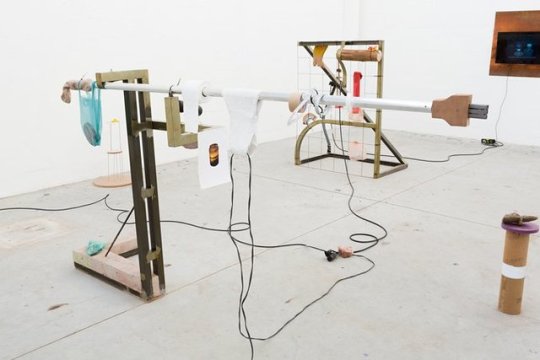#neil beloufa
Photo

Neïl Beloufa
63 notes
·
View notes
Text
NEIL BELOUFA: “DIGITAL MOURNING”
Non è certo una novità vedere un artista che vorrebbe, attraverso le sue opere, interagire col pubblico. E' una "provocazione" per usare un termine un po' frusto che può essere fatta risalire agli esordi della Body, della Land e anche della Conceptual Art e, se volessimo essere più precisi, in fondo tutta l'arte vorrebbe, se non proprio interagire, quantomeno dialogare col pubblico, ma il discorso porterebbe troppo lontano. Anche il giovane e promettente artista Neil Beloufa che presenta nello "Shed" del Pirelli Hangar Bicocca di Milano questa singolare mostra dal titolo "Digital Mourning" (lutto digitale), sembra porsi come principale obiettivo quello di interagire col proprio (e altrui), pubblico. Beloufa si muove nel campo della multidisciplinarietà, ma sarebbe troppo restrittivo inquadrarlo come un artista digitale, anche se l'utilizzo dell'elettronica è certamente la nota dominante del suo lavoro. Le sue complesse installazioni sono volte a creare una molteplicità di punti di vista, tipici di una società pervasa dalla tecnologia digitale. Ma non è tutto così semplice come potreste pensare. Nello spazio espositivo ci accolgono tre figure (dette "host"), tre esseri ibridi (A,B,C) a metà tra scultura e videogioco (magari anche NTF), dove ognuna cerca di catturare l'attenzione del visitatore proponendo,nal proprio interno o sul proprio "corpo", video dell'artista caratterizzati da attitudini stereotipate: quella della conservazione, quella del progressismo, quella ottimista ecc. Vediamo cosa ci propongono gli Host, cominciando con alcuni video dell'Host A. Il suo colore caratterizzante è il blu e ci propone "Kempinski", primo video dell'artista parigino, con interviste agli abitanti di una città del Mali mentre evocano una propria visione del futuro. E' strano, effettivamente, noi non riflettiamo mai su quale visione del futuro abbiano gli abitanti del Terzo Mondo. "Global Agreement" è invece un video con interviste a militari di tutto il mondo che indaga sulle motivazioni che spingono le persone a diventare dei soldati. Tra le proposte più significative dell'Host B, è certamente "Not titled yet", installazione "site specific" per l'Hangar, struttura labirintica che porta ad un ad una sorta di sala interrogatori della polizia, dove un gruppo di uomini e ragazzi americani mette in scena un gioco delle parti, vagamente pirandelliano, dove ognuno è un po' giudice e un po’ indagato. L'Host C, col suo colore rosso, presenta un bellissimo "disegno a tre dimensioni" di filo tubolare che rappresenta un interno domestico con una parete occupata da un monitor, che proietta un video nel quale l'artista intervista sei persone, i cui comportamenti vengono analizzati a distanza per stabilire se sia possibile prevedere algoritmicamente i comportamenti altrui con esito (fortunatamente) negativo. Opera di grande intensità concettuale e allo stesso tempo visivamente molto suggestiva. Dell'Host C però mi piace anche ricordare "Monopoly Podium", video con una ripresa "zenitale" di un gruppo di ragazzi che stanno giocando ad una versione del famoso gioco Monopoli dove, anziché acquistare immobili e alberghi in Via Accademia o in Viale Monte Rosa, in palio ci sono pezzi dell'Ucraina, con un riferimento, nemmeno troppo velato, all'inarrestabile espansionismo russo. Chiude l'esposizione, "La morale de l’histoire", video immersivo tra sculture biomorfe e digitali sulle tematiche dell'accumulazione capitalistica , l'individualismo e l'estinzione dell'uomo, inghiottito dall'istinto iper-individualistico. Se non avete ancora visitato l'inquietante "Breath Ghosts Blind" di Maurizio Cattelan nella navata centrale dell'Hangar, approfittatene per dare anche un'occhiata, anzi più di un'occhiata, all'opera di Neil Beloufa, perché oltre che essere "spiegata", l'arte deve principalmente essere esperita.
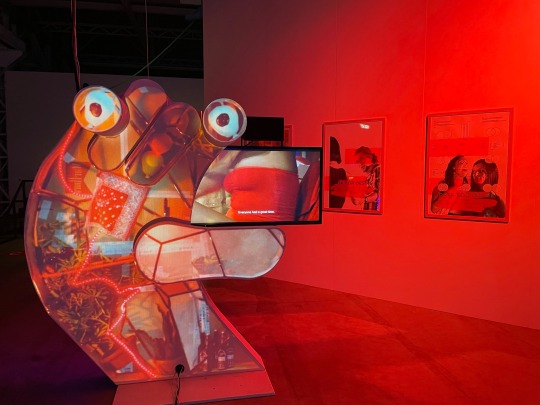
3 notes
·
View notes
Photo
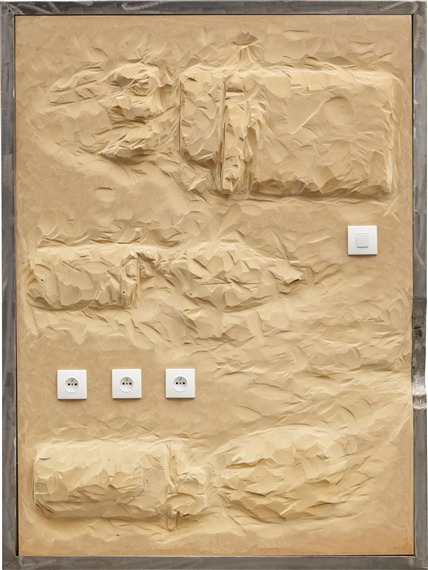
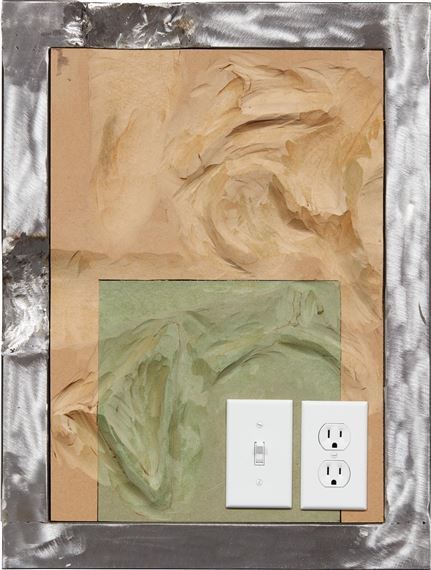
Neil Beloufa, Vintage Series: Lighters and Hangers, 2013
Steel, MDF, electrical wire and plug
2 notes
·
View notes
Text

Följer för mkt danska tumblrs men kan ej sluta intressera mig för dansk tumblr ungdom

Ave maria
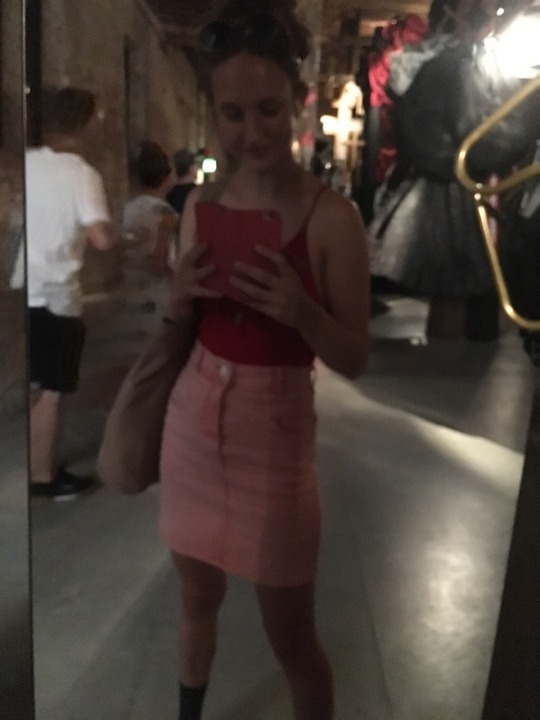
Jag skäms över att jag har såntdär mobilskal men om jag inte har det går jag tillbaka till min gamla ”rutin” som är alla viktiga kort lösa i diverse fickor som slutar med att jag tappar bort allt
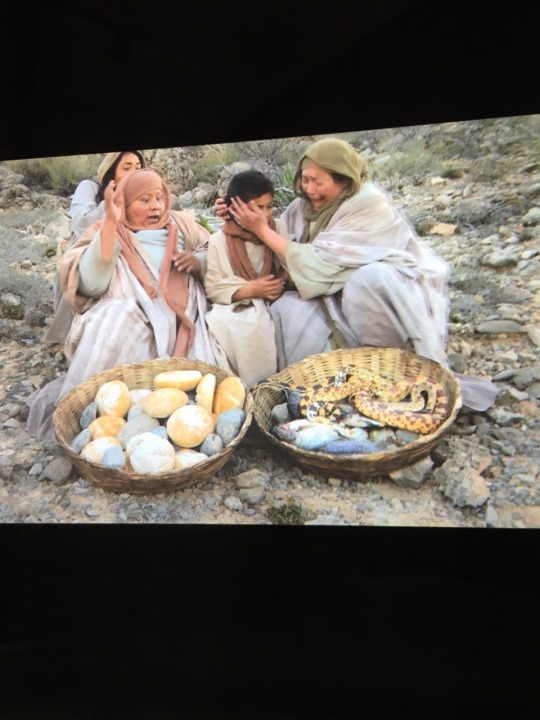
Venedig

Biennalen
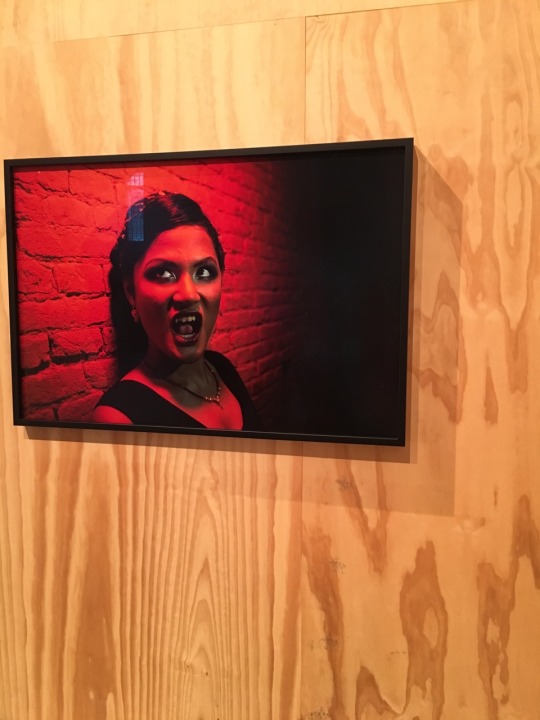
-”-
2 notes
·
View notes
Photo
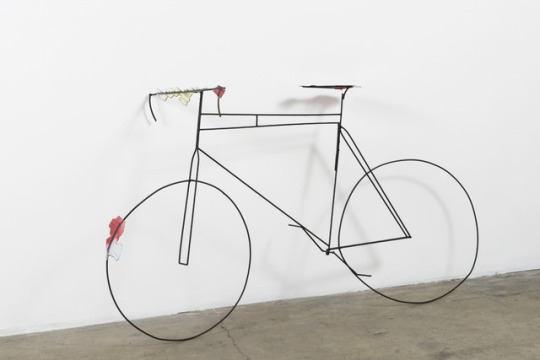
Neil Beloufa, Untitled, 2016
136 notes
·
View notes
Photo
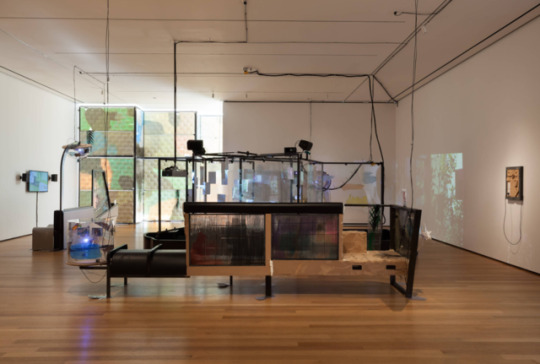
FEATURED ARTIST: Neil Beloufa
French-Algerian artist Neil Beloufa’s practice deftly combines sculpture and moving-image media to create immersive viewing spaces. Within custom-built environments composed of inexpensive construction materials and seemingly improvised/homespun techniques, Beloufa treats projections like objects, deliberately obstructing and diffusing images onto multiple surfaces. The result is a kind of provisional armature for the films, a material counterpart to the videos’ own socially oriented complications of fiction and reality.
Neil Beloufa (b. 1985) lives and works in Paris, New York, and Los Angeles. He studied at The Cooper Union, California Institute of the Arts, Ensad, Arts Décoratifs de Paris (National superior school of Art and Design), Beaux-Arts de Paris (National superior school of Fine Arts), and Studio National d’Art contemporain. Notable past exhibitions include solo presentations at Ghebaly Gallery, Los Angeles (2016); The Museum of Modern Art, New York (2016); ICA, London (2013); Hammer Museum, Los Angeles (2013), Palais de Tokyo, Paris (2012); as well as group shows including Here and Elsewhere, New Museum, New York (2014); Taipei Biennial (2014), Dissident Futures, Yerba Buena Center for the Arts, San Francisco (2013), Lyon Biennale (2013), 55th Venice Biennale, “The Encyclopedic Palace”, Venice, Italy (2013), and Better Homes, SculptureCenter, New York (2013). Locally, his work has been shown at Anthology Film Archives and Whitebox Art Center, among other venues.
Click here to view Neil Beloufa’s work in SculptureCenter’s 2013 exhibition Better Homes, curated by Ruba Katrib.
Installation view, Neïl Beloufa, "The Colonies", 2016. Museum of Modern Art, New York. Photos courtesy of Ghebaly Gallery and the artist.
sculpture-center.org
ELL
28 notes
·
View notes
Photo
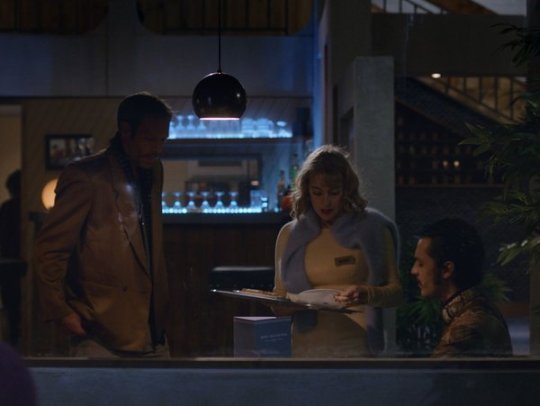
Seen in 2019:
Occidental (Neil Beloufa), 2017
0 notes
Photo
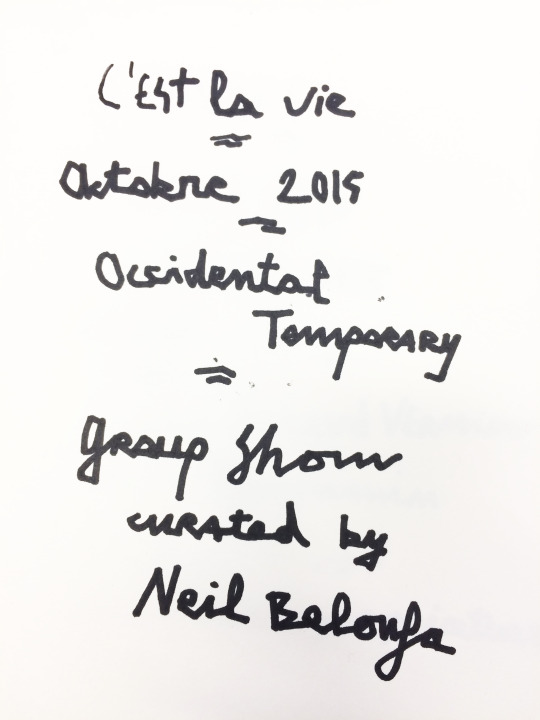
1 note
·
View note
Text
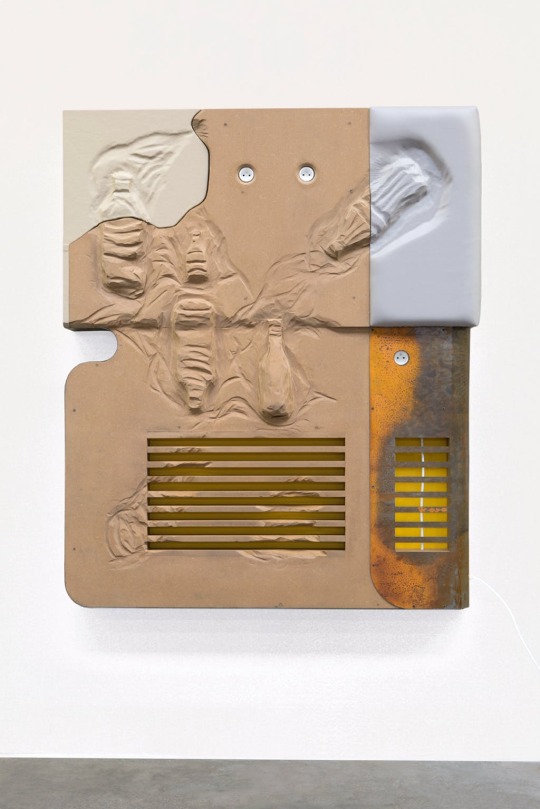
Neïl Beloufa
Bottles on Brown
2019
MDF, bois, acier corten, cuir artificiel, prise electrique / MDF, wood, corten steel, artificial leather, electric plug, electric outlet
160 x 130 x 16 cm
(62,99 x 51,18 x 6,3 in.)
(Inv n°NB5) https://kamelmennour.com/artists/neil-beloufa/bottles-on-brown
7 notes
·
View notes
Photo
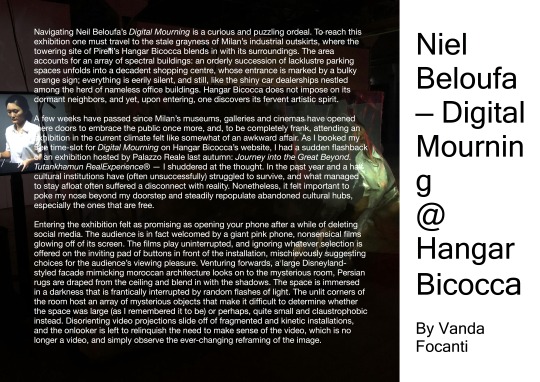
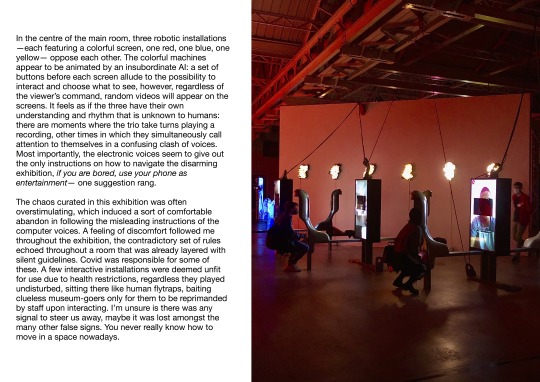
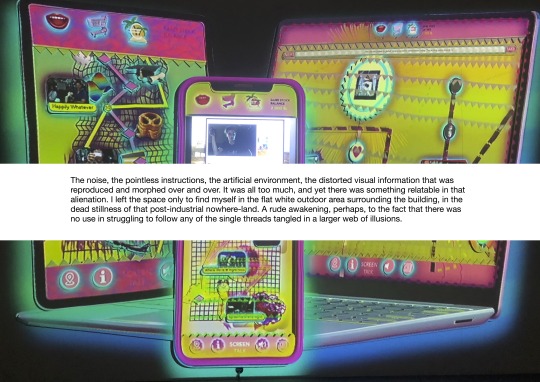
Exhibition Review of Neil Beloufa’s Digital Mourning @ Pirelli Hangar Bicocca, Milan. Full Text provided below.
----
Navigating Neil Beloufa’s Digital Mourning is a curious and puzzling ordeal. To reach this exhibition one must travel to the stale grayness of Milan’s industrial outskirts, where the towering site of Pirelli’s Hangar Bicocca blends in with its surroundings. The area accounts for an array of spectral buildings: an orderly succession of lackluster parking spaces unfolds into a decadent shopping centre, whose entrance is marked by a bulky orange sign; everything is eerily silent, and still, like the shiny car dealerships nestled among the herd of nameless office buildings. Hangar Bicocca does not impose on its dormant neighbors, and yet, upon entering, one discovers its fervent artistic spirit.
A few weeks have passed since Milan’s museums, galleries and cinemas have opened there doors to embrace the public once more, and, to be completely frank, attending an exhibition in the current climate felt like somewhat of an awkward affair. As I booked my free time-slot for Digital Mourning on Hangar Bicocca’s website, I had a sudden flashback of an exhibition hosted by Palazzo Reale last autumn: Journey into the Great Beyond. Tutankhamun RealExperience® — I shuddered at the thought. In the past year and a half cultural institutions have (often unsuccessfully) struggled to survive, and what managed to stay afloat often suffered a disconnect with reality. Nonetheless, it felt important to poke my nose beyond my doorstep and steadily repopulate abandoned cultural hubs, especially the ones that are free.
Entering the exhibition felt as promising as opening your phone after a while of deleting social media. The audience is in fact welcomed by a giant pink phone, nonsensical films glowing off of its screen. The films play uninterrupted, and ignoring whatever selection is offered on the inviting pad of buttons in front of the installation, mischievously suggesting choices for the audience’s viewing pleasure. Venturing forwards, a large Disneyland-styled facade mimicking moroccan architecture looks on to the mysterious room, Persian rugs are draped from the ceiling and blend in with the shadows. The space is immersed in a darkness that is frantically interrupted by random flashes of light. The unlit corners of the room host an array of mysterious objects that make it difficult to determine whether the space was large (as I remembered it to be) or perhaps, quite small and claustrophobic instead. Disorienting video projections slide off of fragmented and kinetic installations, and the onlooker is left to relinquish the need to make sense of the video, which is no longer a video, and simply observe the ever-changing reframing of the image.
In the centre of the main room, three robotic installations —each featuring a colorful screen, one red, one blue, one yellow— oppose each other. The colorful machines appear to be animated by an insubordinate AI: a set of buttons before each screen allude to the possibility to interact and choose what to see, however, regardless of the viewer’s command, random videos will appear on the screens. It feels as if the three have their own understanding and rhythm that is unknown to humans: there are moments where the trio take turns playing a recording, other times in which they simultaneously call attention to themselves in a confusing clash of voices. Most importantly, the electronic voices seem to give out the only instructions on how to navigate the disarming exhibition, if you are bored, use your phone as entertainment— one suggestion rang.
The chaos curated in this exhibition was often overstimulating, which induced a sort of comfortable abandon in following the misleading instructions of the computer voices. A feeling of discomfort followed me throughout the exhibition, the contradictory set of rules echoed throughout a room that was already layered with silent guidelines. Covid was responsible for some of these. A few interactive installations were deemed unfit for use due to health restrictions, regardless they played undisturbed, sitting there like human flytraps, baiting clueless museum-goers only for them to be reprimanded by staff upon interacting. I’m unsure is there was any signal to steer us away, maybe it was lost amongst the many other false signs. You never really know how to move in a space nowadays.
The noise, the pointless instructions, the artificial environment, the distorted visual information that was reproduced and morphed over and over. It was all too much, and yet there was something relatable in that alienation. I left the space only to find myself in the flat white outdoor area surrounding the building, in the dead stillness of that post-industrial nowhere-land. A rude awakening, perhaps, to the fact that there was no use in struggling to follow any of the single threads tangled in a larger web of illusions.
#hangarbicocca#neilbeloufa#exhibition review#exhibition#art blog#culture#writing#criticism#art criticism#art#art museum#creative writing#milan
4 notes
·
View notes
Photo

Installation view of Neil Beloufa's solo presentation with Ghebaly Gallery (N22) in the Nova sector.
7 notes
·
View notes
Photo

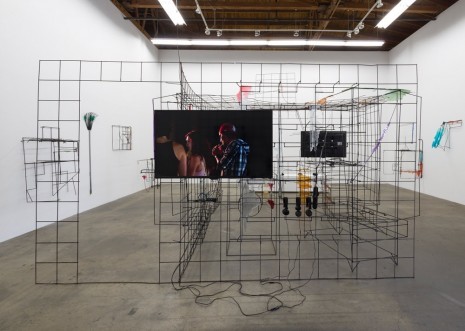
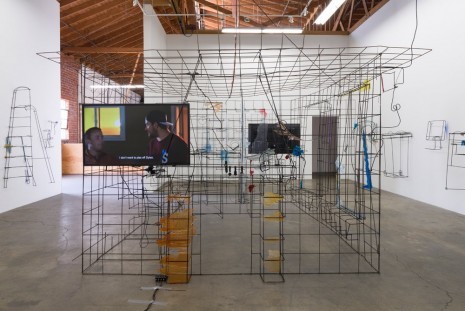
(via Artist : Neil Beloufa | Daily Art Fair)
Neil Beloufa
9 notes
·
View notes
Photo

L’ENNEMI DE MON ENNEMI, au Palais de Tokyo
L’Ennemi de mon ennemi est un projet conçu par Neïl Beloufa à l’invitation du Palais de Tokyo. C’est un dispositif scénographique représentant de façon extrêmement riche et diversifiée mais à la fois chaotique et parcellaire, la façon dont s’écrit l’Histoire et se légitiment les pouvoirs les plus fous.
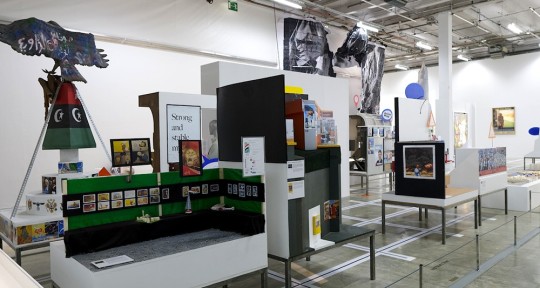
S’inspirant de la communication officielle, des mémoriaux, des musées de guerre, de la propagande politique mais aussi de l’actualité, de la publicité ou des jeux vidéo, l’exposition met en scène l’interchangeabilité des stratégies et des discours. Cette mobilité est cette réversibilité, sont représentées par des wagons mobiles qui déplacent les stands information (et de désinformation) selon un algorithme mystérieux. Le montage technique est impressionnant, il rivalise avec la profusion des messages ainsi brassés.
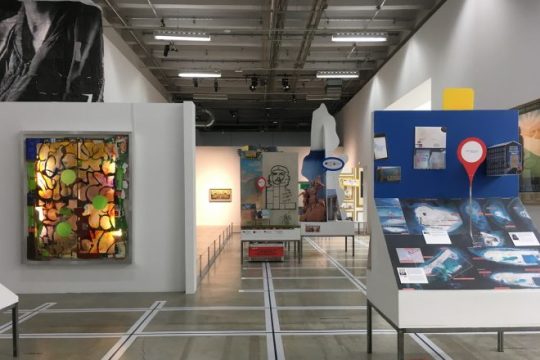
Ce faisant, la mise en scène qui se modifie sans cesse, joue sur une ambiguïté permanente entre le bien et le mal, les gentils et les méchants, les postures et les impostures.
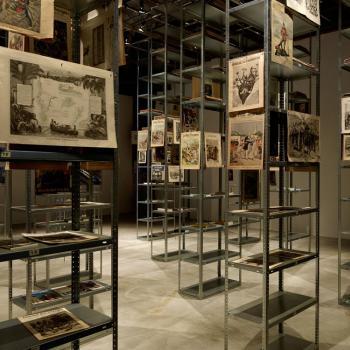
Ce dispositif scénographique très impressionnant d’une créativité débordante, a été spécialement conçu par l’artiste pour l’exposition. Il intègre des œuvres, des documents, des images, des artefacts, des reproductions et des objets réels qui s’associent et se dissocient sans cesse, qui donne à voir ou fait disparaître d’une minute à l’autre. Il propose ainsi une remise en cause permanente des associations, des perspectives et des significations.
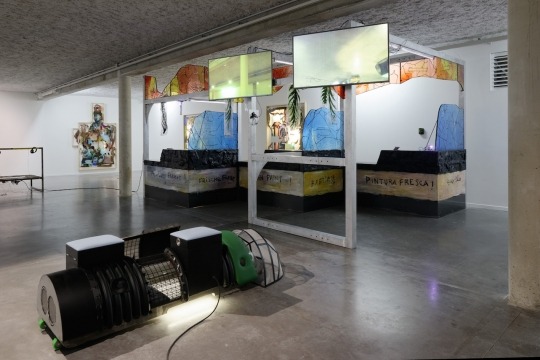
L’Ennemi de mon Ennemi envisage le monde comme un champ de stratégies contradictoires, multiples et pourtant tellement ressemblantes dans leur fond. Elle interroge en sous-main la place de l’artiste dans la multiplicité de ces pouvoirs, entre désir d’autonomie, servitude et propagande.
0 notes

